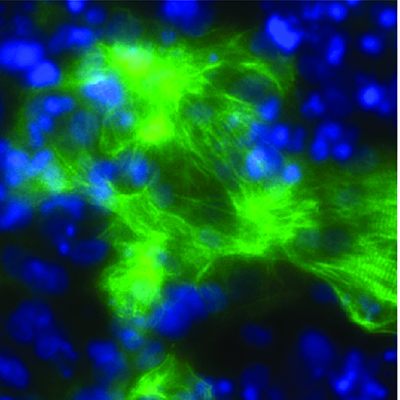October 22, 2020 -- Researchers have identified silent ancient DNA elements buried in the human genome that when "reactivated" can initiate an immune response toward cancer cells. They also identified a key enzyme, normally used by cancer cells to evade immune responses, that can be leveraged against them. The research was published in Nature on October 21.
Therapies that target ancient DNA elements (repressive epigenetic machinery) can mediate antitumor effects by activating retroelements (endogenous components of the genome that can amplify to new locations through an RNA intermediate). Active retroelements generate double-stranded RNA (dsRNA) that can be recognized by melanoma differentiation-associated protein 5 (MDA5) via a mechanism of viral mimicry.
Viral mimicry is the ability to cause cancer cells to behave as though they have been infected, thereby activating the immune system to fight cancer as if it were an infection. Therapies that activate retroelements are known to cause a loss of cancer cell fitness and activate innate and adaptive immune responses. Therefore, the identification of epigenetically induced immunogenic retroelements would be informative in the development of cancer therapeutics.
"Humans acquired a series of 'silent' repetitive elements in our DNA over millions of years of evolution, but it has been unclear why or what purpose they serve," explained Daniel De Carvalho, senior scientist at Princess Margaret Cancer Centre in Toronto, in a statement. "As 'genome archeologists', we set out to identify the function of these 'DNA relics' and have found that under the right conditions they can be reactivated and stimulate our immune system."
Identifying 'ancient' cancer weapons
The researchers found that when short interspersed nuclear elements (SINEs) -- a type of "ancient" DNA that is noncoding -- are activated by epigenetic drugs (DNA methyltransferase inhibitors) there is an increase in the amount of dsRNA produced. To determine this, the team used RNA sequencing strategies on patient-derived colorectal cancer cells treated with the epigenetic drug.
Treatment with the epigenetic therapy led to the predominant production of a very specific type of immunogenic dsRNA called inverted repeated Alu structures (IR-Alus), forming RNA stem-loops that stimulate MDA5 and mechanisms of viral mimicry. The dsRNA is enriched for orphan CpG islands (which promote replication outside of promoter regions of the genome) and acquired active epigenetic marks (namely histone 3 lysine 4 trimethylation; H3K4me3) after treatment.
De Carvalho likened this response to an "ancient dagger that can be used against cancer."
How cancer cells evade viral mimicry and how to block it
Cancer cells have many known mechanisms of evading detection by the host immune system. For instance, cancer cells use the RNA-editing enzyme adenosine deaminase acting on RNA 1 (ADAR1) to restrict the viral mimicry response induced by epigenetic therapies in cancer cells through a negative feedback loop.
ADAR1 regulates dsRNA through adenosine-to-inosine (A-to-I) editing and subsequent destabilization of RNA duplexes. The main substrate for the enzyme is RNA stem-loops formed by IR-Alu elements.
The researchers demonstrated that ADAR1 depletion in human cancer cells sensitizes tumors to treatment with epigenetic drugs. Therefore, the combination of epigenetic therapies and depletion of ADAR1 (via knockdown) resulted in profoundly depressed growth of colorectal cancer cells.
"Since the ADAR1 activity is enzymatic, our work provides an exciting new target for drug development efforts for a completely new class of drugs that are able to exploit these 'ancient weapons' in our genome," explained Dr. De Carvalho.
Do you have a unique perspective on your research related to cancer research or cell biology? Contact the editor today to learn more.
Copyright © 2020 scienceboard.net







